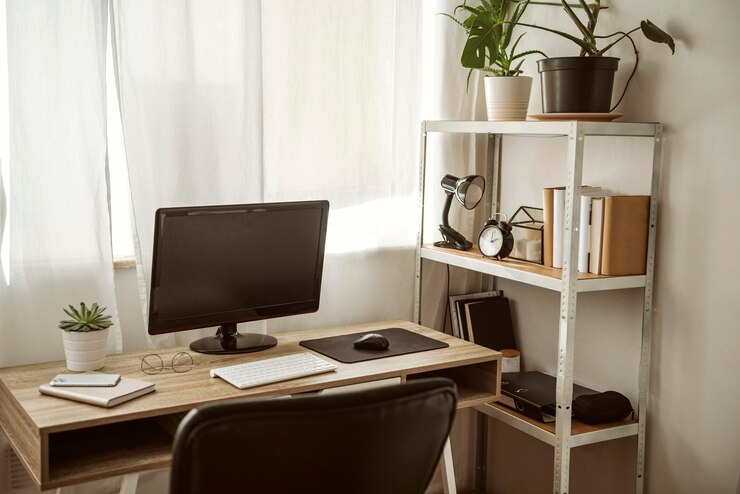07 Oct

|
Getting your Trinity Audio player ready...
|
In today’s remote work environment, a productive home office is crucial for freelancers, corporate employees, and creative professionals alike. This blog post offers practical tips to optimize your workspace, including selecting the right location, furniture, and technology, as well as adding personal touches to create an inspiring and efficient setup.
Table of Contents
Designing Your Home Office Space
Designing your home office begins with selecting the perfect location within your home. The right spot can make all the difference in how you work and feel throughout the day. Ideally, choose a quiet area with minimal distractions where you can focus without interruptions. If possible, position your office away from high-traffic areas like the kitchen or living room. This separation helps establish a mental boundary between work and home life.
Once you’ve chosen your location, consider how the space can align with your work needs and personal preferences. Think about the type of work you do and what equipment you’ll need. Will you require ample desk space, filing cabinets, or a creative corner for brainstorming sessions? Tailor your setup to accommodate your work style and ensure that everything you need is within arm’s reach.
Finally, don’t forget to add a touch of personality to your workspace. While functionality is crucial, incorporating elements that reflect your taste can make your office a more inviting place. Add artwork, plants, or a motivational quote that resonates with you. These touches can boost your mood and make your office feel like your own.
Ergonomics and Comfort
Ergonomics is a vital aspect of any productive home office. Poor posture and uncomfortable furniture can lead to fatigue and physical strain, ultimately affecting your work performance. Invest in ergonomic furniture like a supportive chair and an adjustable desk to maintain a healthy posture throughout the day.
Setting up your workstation for maximum comfort involves more than just choosing the right furniture. Pay attention to the placement of your computer monitor, keyboard, and mouse. Your monitor should be at eye level to prevent neck strain, and your keyboard and mouse should be positioned so that your wrists remain straight and relaxed. Consider using a wrist rest or an ergonomic mouse pad for added support.
Remember, comfort extends beyond furniture. Take breaks to stretch and move around during the day. Incorporate exercises that target common problem areas like the neck, shoulders, and lower back. By prioritizing ergonomics and comfort, you’ll create an environment where you can work efficiently without compromising your health.
Maximizing Natural Light and Air Quality
Natural light and fresh air are powerful boosters of productivity and well-being. A well-lit workspace can improve your mood and energy levels, while good air quality can enhance focus and cognitive function. To make the most of these elements, position your desk near a window to maximize natural light exposure. If direct sunlight is too harsh, consider using sheer curtains or blinds to diffuse the light pleasantly.
In addition to natural light, ensure your home office has proper ventilation. Fresh air can help reduce the buildup of indoor pollutants and promote a healthier work environment. If possible, open windows regularly to allow fresh air to circulate. You can also incorporate indoor plants like spider plants or peace lilies, which can naturally purify the air and add a touch of greenery to your office.
Don’t overlook the impact of artificial lighting. Use a combination of overhead lights and desk lamps to create a well-lit workspace during darker hours. Consider adjustable lamps with warm or cool light settings to suit different tasks and times of the day.
Organization and Storage
A clutter-free workspace contributes significantly to productivity and mental clarity. A tidy environment minimizes distractions and allows you to concentrate on your tasks. Start by decluttering your desk and organizing your essentials. Use trays, organizers, or drawers to keep office supplies neatly arranged.
Efficient storage solutions can help maintain order in your home office. Store files and documents in a filing cabinet or use digital storage options to reduce paper clutter. Shelving units or bookcases are excellent for keeping books, reference materials, and decorative items in order.
Regularly assess your workspace for clutter and take time to tidy up. A clean and organized office creates a positive atmosphere that encourages focused and productive work sessions.
Technology and Connectivity
In a digital age, having the right technology is essential for a productive home office. Ensure your workspace is equipped with the necessary tools, such as a reliable computer, printer, and other devices relevant to your work. Consider visiting a computer store, like those in Sandy, to explore the latest gadgets and technologies that can enhance your workflow.
To optimize your internet connectivity, position your router in a central location and avoid placing it near obstacles that could interfere with the signal. If necessary, invest in a Wi-Fi extender to ensure a strong and stable connection throughout your office.
Managing digital distractions is another key aspect of maintaining productivity. Set boundaries for checking emails and social media during work hours, and use apps or browser extensions that block distracting websites if needed.
Setting Boundaries and Creating a Routine
Working from home offers flexibility, but it also presents unique challenges in separating work and personal life. Establishing clear boundaries between these aspects is crucial for maintaining a healthy work-life balance. Communicate your work schedule to family and housemates, and encourage them to respect your focused time.
Creating a daily routine can help you stay organized and motivated. Set specific work hours and create a schedule that includes regular breaks. Structure your day to include tasks, meetings, and time for relaxation. A consistent routine enhances productivity and prevents burnout.
Remember to also disconnect from work at the end of the day. Close your computer, tidy up your workspace, and engage in activities that help you relax and recharge for the next day.
Personalizing Your Space
Your home office should reflect your personality and preferences while maintaining a professional atmosphere. Personalizing your workspace can enhance your motivation and creativity, making it an inspiring place to work.
Consider adding personal touches like artwork, family photos, or a vision board that keeps you focused on your goals. Incorporate colors and textures that resonate with you and create a comfortable ambience. Just ensure that your personal touches don’t clutter the space or detract from the professional environment.
By infusing your workspace with elements that bring you joy, you’ll create a home office that feels uniquely yours, promoting a sense of ownership and pride in your work.
Conclusion
Now that you have gathered all the essential components for a productive home office, it’s time to put them into practice. Keep in mind that individual needs and preferences vary, so feel free to experiment and discover what suits you best. Prioritize your well-being and comfort while designing a functional and inspiring workspace. With these tips in hand, you’ll be well on your way to creating a successful and efficient home office. Happy working!


